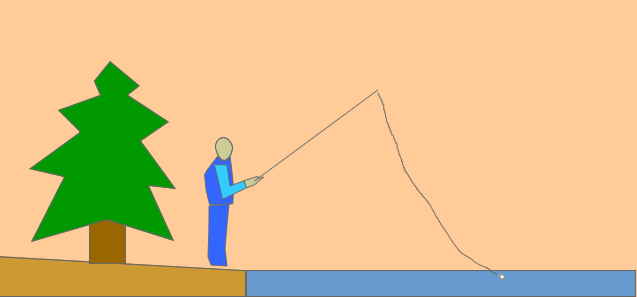The steeple cast is used when there are objects behind you that do not allow a backcast; such as a cliff, trees, brush. Another constraint could be fast water in front of you which negates the roll cast. With the steeple cast, you turn your wrist upside down on a horizontal backswing and bring the rod vertically into the air above your head. Before the line completely unfurl's, start your forward overhead cast as normal. The distance attained is generally no more than 30 feet.
The steeple cast has a few other advantages over the roll cast:
- The line and fly are not on the water. Thus, a dry fly will not get water-logged and the line pick-up will not be influenced by the current.
- If you are nymphing with two flies and have extra weight, it is easier to pick-up the line off the water and cast.
- You can change direction in midair and locate your target more accurately.
Procedure
1. Begin with your rod tip close to the water. Rotate your wrist so that the reel faces upward.
2. Start your backstroke like a sidearm cast, rotating from the elbow just above a horizontal plane, and then swing your arm into a vertical position. When the rod tip reaches the 12 o'clock position, your upper arm is at a 90 degree angle in front of your body and the forearm will be vertical with your palm facing forward. Stop the rod abruptly to load the rod and allow the line to lay out overhead.
3. Since you start the cast out in a sidearm plane, keep your reel face facing forward and your arm angle mirroring the angle of the line until it reaches its apex. In other words, this isn't a cast where the line has a clear back-and-forth path, so you will need to let your forearm imitate the path of the line or the line will get tangled with your rod tip.
4. Keep the backcast (which is really an upcast) over your casting shoulder (and once you get the hang of it, bring your arm a little over your head). Keep the line high and tight, like a taut clothesline fastened to a point directly over your head.
5. Punch hard through the forward cast and stop your cast at the 9 or 10 o'clock position. If the line is getting tangled on the upstroke, your extended arm is not following the angle of the backcast/upstroke line. Another way to keep the line from tangling is to use more of an outward and upward sweeping motion on the backstroke, like waving a wand or leading an orchestra.
|


